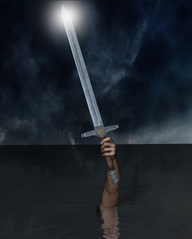 Excalibur rising from the Lake
Excalibur rising from the Lake To answer a question about Excalibur we have have to go back to the question that underlies every other question about King Arthur and the Knights of the Round Table. Was Arthur a real person and when did he live?
If a general, or war leader, or chieftain named Arthur actually existed he was either a Roman or someone who rose to power shortly after the fall of the Roman Empire.
If a general, or war leader, or chieftain named Arthur actually existed he was either a Roman or someone who rose to power shortly after the fall of the Roman Empire.
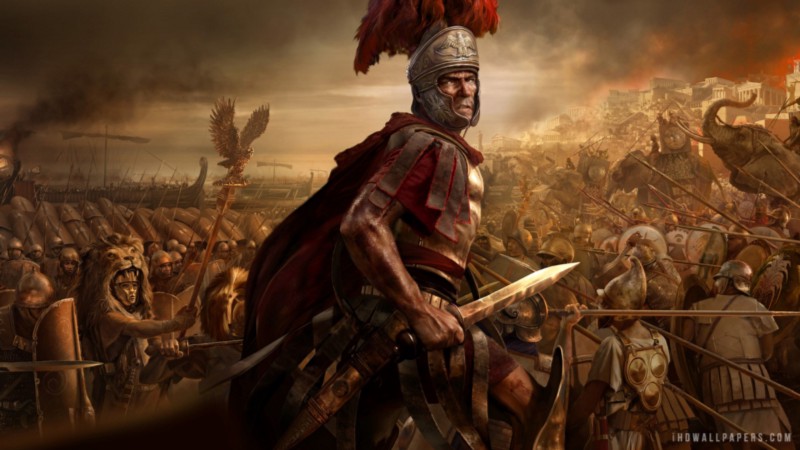 Roman soldier with a short sword
Roman soldier with a short sword Romans used the word gladius to refer to their type of sword. Initially made of iron, by the time Rome fell, the gladii were made of steel. They were two edged for cutting and had a tapered point for stabbing and they were short, more akin to a long dagger than an elegant magical sword. There was no swashbuckling involved in fighting with a standard Roman sword. No leaping from balconies or swinging from chandeliers. Roman soldiers were trained to use their swords for stabbing and to aim for the stomach. Stomach wounds were almost always fatal. The sharp edge of the blade could be used for cutting at the knees. Fighting with a Roman sword was a bloody business relying on rigorous training and the quick kill. The sword was just over 2ft in length meaning that the combat was up close and personal. If Excalibur was a Roman sword, it was a simple instrument, with a wooden hilt, perhaps some engraving of the owner's name on the blade, and very unlikely to be ornamented with precious metals or jewels of any kind.
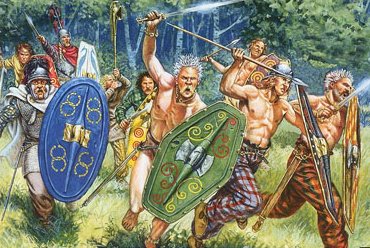 The long swords of the Celts
The long swords of the Celts Perhaps Arthur was not a Roman. He is often depicted as a Celt. The Celts were known for their skill in sword making and especially for their ability to make long swords, some as long as 6ft. They were given to naming their swords and decorating them with ivory, gold, and precious stones. They placed swords in sacred lakes and rivers to honor their dead. Archaeologists today find lakes and rivers to be a good source of artifacts. So, with the Celtic sword, are we getting closer to the fabled Excalibur?
 A Pictish warrior with a curved sword
A Pictish warrior with a curved sword The Romans conquered many of the Celtic tribes living in what is now England but they failed to conquer the members of an even more ancient society, the Picts of Scotland. Although they fought one pitched battle in which many Picts were destroyed, Rome never managed to keep a foothold in Scotland. The Picts retreated to the mountains and lived free of the Romans. Was Arthur a Pict, was Excalibur a Pictish sword? Unlikely. The Picts were renowned for fighting naked, and this has never been said of Arthur, and their swords were curved, and this has never been said of Excalibur.
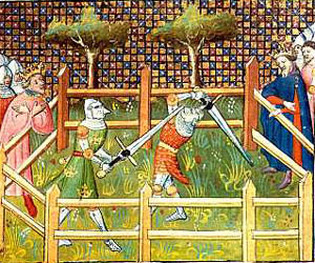 A 14th Century recreation of the Arthurian legends
A 14th Century recreation of the Arthurian legends So let's move on to fantasy Arthur. Edward III a 14th century King of England exploited the Arthurian myth to bolster his own popularity. He staged mock Arthurian tournaments, and bestowed Arthurian honors on his favorites. The style that many of us associate with the legendary Arthur is in fact the High Medieval style of Edward III. By the 14th Century the sword had evolved from the short stab-you-in-the-stomach blade of the Romans to an instrument of greater elegance about 4ft long and light enough to be used one-handed on horseback and two handed when on foot.
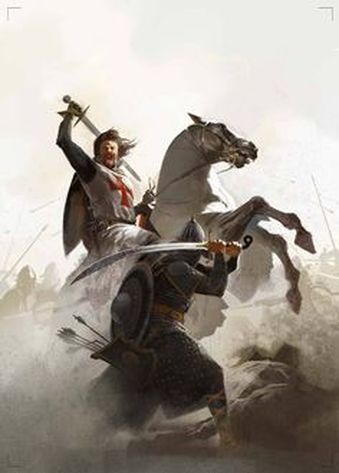 A Crusader fights a Saracen with a sword of Damascus Steel
A Crusader fights a Saracen with a sword of Damascus Steel Of course we can't discount the possibility that Excalibur was a foreign import. Rome had conquered most of the known world and no doubt soldiers collected battlefield souvenirs and brought them home. Perhaps one of those souvenirs was a particularly well-made sword.
In the Middle Ages, English knights joined the Crusades and traveled far and wide. As they made their way to Jerusalem and the battlefields of the Middle East, they encountered weapons made of Damascus Steel. These weapons were light, flexible and kept their edge. A Saracen sword would be something to be treasured and perhaps endow with mystical properties.
In the Middle Ages, English knights joined the Crusades and traveled far and wide. As they made their way to Jerusalem and the battlefields of the Middle East, they encountered weapons made of Damascus Steel. These weapons were light, flexible and kept their edge. A Saracen sword would be something to be treasured and perhaps endow with mystical properties.
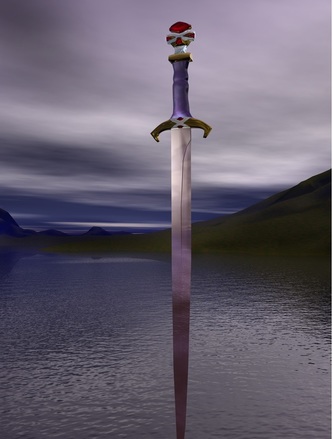 Excalibur rises from the water
Excalibur rises from the water However, when we consider a sword that has a name, is long and heavily ornamented and has connections to water (as in the sword given to Arthur by the Lady of the Lake) and if we want the story of Arthur to be rooted in any kind of historical truth, Excalibur cannot be a sword from the HIgh Middle Ages, and is most likely to be a Celtic sword from the time of the Roman occupation of Britain or soon after.
In the Excalibur Rising series of Arthurian time travel novels, I offer another compelling and much darker explanation of the origin of Excalibur and its relation to King Arthur. The First Chronicle and Second Chronicle are now available in paperback formats. Both Chronicles together are available in the Omnibus Edition in the E-book format only.
In the Excalibur Rising series of Arthurian time travel novels, I offer another compelling and much darker explanation of the origin of Excalibur and its relation to King Arthur. The First Chronicle and Second Chronicle are now available in paperback formats. Both Chronicles together are available in the Omnibus Edition in the E-book format only.

 RSS Feed
RSS Feed